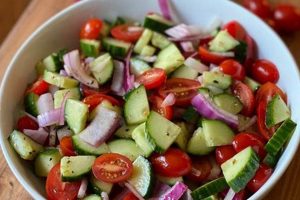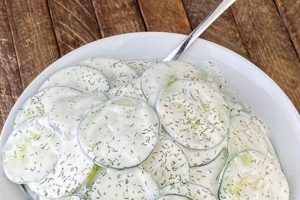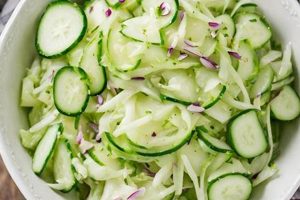A refreshing and simple dish, this type of salad typically combines sliced cucumbers and tomatoes with a vinaigrette based on vinegar. Variations can include additional ingredients such as onions, herbs (like dill or parsley), or spices for enhanced flavor and texture. The vinegar provides a tangy base, complementing the cool crispness of the cucumbers and the sweetness of the tomatoes.
Such salads offer a light and healthy meal option, ideal for warm weather. The ingredients are readily available and affordable, making it an economical choice. Vinegar-based dressings contribute to improved digestion and can help regulate blood sugar levels. Furthermore, the high water content of cucumbers and tomatoes promotes hydration. This culinary approach has likely existed for centuries, utilizing readily available garden produce and simple preservation methods like vinegar.
This foundational understanding allows for a deeper exploration into the nuances of ingredient selection, variations on the basic recipe, and tips for achieving optimal flavor and texture.
Tips for a Perfect Cucumber Tomato Vinegar Salad
Optimizing ingredient preparation and combining techniques can elevate this simple salad to a culinary delight.
Tip 1: Salt the cucumbers. Salting sliced cucumbers draws out excess moisture, preventing a watery salad. Place cucumber slices in a colander, sprinkle with salt, and let them sit for 15-20 minutes before rinsing and drying. This enhances their flavor and maintains the salad’s crispness.
Tip 2: Use high-quality vinegar. The vinegar is the heart of the dressing. Opt for a good-quality vinegar like apple cider, white wine, or red wine vinegar. Experiment with different types to discover preferred flavor profiles.
Tip 3: Balance acidity with sweetness. A touch of sweetness balances the vinegar’s acidity. A small amount of sugar, honey, or maple syrup can create a more rounded and palatable dressing.
Tip 4: Incorporate fresh herbs. Fresh herbs like dill, parsley, mint, or chives add depth and complexity to the salad. Chop them finely and add them just before serving for optimal flavor and aroma.
Tip 5: Use ripe, flavorful tomatoes. The quality of tomatoes significantly impacts the overall taste. Choose ripe, in-season tomatoes for the best flavor and texture.
Tip 6: Consider adding red onion. Thinly sliced red onion contributes a pungent bite and vibrant color. Soaking the sliced onion in cold water for a few minutes can mellow its intensity.
Careful attention to these details ensures a balanced, flavorful, and visually appealing salad. Proper technique maximizes the freshness and inherent qualities of each ingredient.
By understanding these core principles, one can confidently create a delicious and refreshing salad experience.
1. Fresh Ingredients
The quality of a cucumber tomato vinegar salad hinges directly on the freshness of its components. Peak-season produce delivers optimal flavor, texture, and nutritional value, significantly impacting the final dish.
- Cucumbers:
Firm, vibrant green cucumbers with no signs of shriveling or bruising are essential. Locally sourced, in-season cucumbers offer superior crispness and a cleaner taste compared to those stored for extended periods. The variety of cucumber also influences the final result; English cucumbers, for example, tend to be less watery and have a thinner skin.
- Tomatoes:
Ripe, fragrant tomatoes contribute sweetness and juiciness. In-season tomatoes, whether heirloom or vine-ripened, offer a depth of flavor often absent in those harvested prematurely. Avoiding overly soft or blemished tomatoes ensures optimal texture in the salad.
- Vinegar:
While not a produce item, the vinegar’s freshness plays a role. High-quality vinegar, properly stored and within its best-by date, delivers a clean, sharp acidity that complements the other ingredients. Different vinegar types offer unique flavor profiles, and experimenting can enhance the salad’s complexity.
- Herbs (Optional):
If incorporating fresh herbs, their quality is equally crucial. Vibrant, unwilted herbs like dill, parsley, or mint provide a burst of fresh aroma and flavor. Adding herbs just before serving preserves their delicate nature and maximizes their impact.
Utilizing the freshest ingredients elevates this simple salad from satisfactory to exceptional. The synergy between these components, when at their peak, creates a vibrant and refreshing culinary experience. Prioritizing quality ingredients ensures a flavorful and satisfying result that highlights the inherent simplicity of the dish.
2. Balanced Vinaigrette
The vinaigrette serves as the unifying element in a cucumber tomato vinegar salad, binding the individual ingredients and significantly influencing the overall flavor profile. A well-balanced vinaigrette enhances the inherent qualities of the cucumbers and tomatoes without overpowering their delicate flavors. Achieving this balance requires careful consideration of acidity, sweetness, and the incorporation of other complementary components.
- Acidity
Vinegar provides the essential acidity, acting as a counterpoint to the sweetness of the tomatoes and the mildness of the cucumbers. The type of vinegar chosen significantly impacts the final result. For example, a robust red wine vinegar offers a more assertive tang, while a milder apple cider vinegar provides a subtle sweetness. The concentration of the vinegar should be adjusted according to personal preference and the specific ingredients used. An overly acidic vinaigrette can overwhelm the salad, while insufficient acidity can result in a bland dish.
- Sweetness
A touch of sweetness balances the sharpness of the vinegar, creating a more harmonious flavor profile. This can be achieved through the addition of a small amount of sugar, honey, or maple syrup. The level of sweetness should complement the acidity, creating a nuanced interplay of flavors. Over-sweetening can mask the freshness of the vegetables, while insufficient sweetness can result in an overly tart dressing.
- Oil
Oil contributes richness and texture to the vinaigrette, coating the vegetables and creating a more palatable mouthfeel. Extra virgin olive oil is a common choice, offering a fruity and peppery flavor that complements the other ingredients. Other oils, like avocado or grapeseed oil, can also be used depending on the desired flavor profile. The ratio of oil to vinegar influences the dressing’s consistency and richness.
- Additional Flavor Components
Beyond the core components, additional elements can elevate the vinaigrette and add complexity to the salad. Minced garlic or shallot can provide a pungent bite, while a pinch of Dijon mustard adds a subtle creaminess and depth of flavor. Freshly cracked black pepper contributes a subtle spiciness, while a pinch of salt enhances the overall flavor profile. These additions should be used judiciously to avoid overpowering the delicate flavors of the cucumbers and tomatoes.
A well-executed vinaigrette elevates the cucumber tomato vinegar salad from a simple combination of ingredients to a harmonious and flavorful dish. The interplay of acidity, sweetness, and complementary flavors creates a balanced and refreshing culinary experience that highlights the inherent qualities of each component. The careful consideration of these elements is crucial for achieving a truly exceptional salad.
3. Proper Technique
Proper technique plays a crucial role in maximizing the flavor and textural appeal of a cucumber tomato vinegar salad. While seemingly simple, this salad benefits significantly from specific preparatory steps that prevent common pitfalls, such as excess moisture and uneven flavor distribution. These techniques, while straightforward, demonstrably impact the final product’s quality.
One key technique involves salting the cucumbers prior to incorporating them into the salad. This process draws out excess moisture, preventing a watery final product. Placing thinly sliced cucumbers in a colander, sprinkling them with salt, and allowing them to rest for approximately 15-20 minutes effectively reduces their water content. Rinsing and thoroughly drying the cucumbers afterwards removes excess salt and prepares them for optimal integration into the salad. Neglecting this step can result in a diluted dressing and a less satisfying textural experience.
Another important consideration lies in the timing of ingredient combination. Adding the vinaigrette dressing immediately before serving prevents the vegetables from becoming soggy. This preserves their crispness and ensures the dressing doesn’t overly macerate the delicate cucumber and tomato slices. Furthermore, the even distribution of the vinaigrette across all ingredients, achieved through gentle tossing, ensures a consistent flavor experience in each bite. Failure to adhere to this timing can lead to an unbalanced and less appealing salad.
In summary, the application of proper techniques, while often overlooked, significantly contributes to the overall success of a cucumber tomato vinegar salad. Salting the cucumbers and timing the dressing application are prime examples of seemingly minor steps that yield substantial improvements in flavor and texture. Understanding and implementing these techniques ensures a consistently satisfying and refreshing culinary outcome.
4. Flavorful Additions
While cucumbers, tomatoes, and a vinegar-based dressing form the foundation of this salad, flavorful additions contribute complexity and depth, elevating the dish beyond its basic components. These additions, ranging from aromatic herbs to pungent alliums, offer a spectrum of flavor profiles that can be tailored to individual preferences and culinary objectives. The judicious incorporation of these elements transforms a simple salad into a nuanced culinary experience.
- Fresh Herbs
Fresh herbs impart brightness and aromatic complexity. Dill, with its slightly tangy and anise-like notes, pairs particularly well with cucumbers. Parsley offers a fresh, grassy flavor, while mint provides a cooling counterpoint. Chives contribute a subtle onion flavor. The herbs should be added just before serving to maintain their vibrancy and prevent wilting.
- Alliums
Alliums, such as red onion or shallots, introduce a pungent bite. Thinly sliced red onion adds a sharp, peppery note and a pop of color. Shallots offer a milder, sweeter onion flavor. Soaking sliced onions in cold water for a few minutes mellows their intensity. These additions provide textural contrast and a savory dimension.
- Spices
A judicious use of spices can further enhance the flavor profile. Freshly cracked black pepper adds a subtle heat, while a pinch of red pepper flakes introduces a more pronounced spiciness. Ground cumin or coriander can provide earthy undertones. The choice of spices should complement the other ingredients and the overall desired flavor profile.
- Other Vegetables
Incorporating other vegetables can broaden the salad’s textural and flavor complexity. Bell peppers contribute sweetness and crunch, while avocado adds creaminess and healthy fats. Chopped celery offers a refreshing bite. These additions create a more substantial and satisfying salad. The choice of additional vegetables should consider their compatibility with the existing flavors and textures.
The strategic incorporation of flavorful additions allows for significant customization and elevates the cucumber tomato vinegar salad from a simple side dish to a more complex and satisfying culinary creation. The careful balance of these elements complements the core ingredients, resulting in a nuanced interplay of flavors and textures that enhances the overall dining experience.
5. Seasonality
Seasonality plays a pivotal role in the ultimate success of a cucumber tomato vinegar salad. Peak-season cucumbers and tomatoes offer superior flavor and texture compared to their out-of-season counterparts. The flavor profile of these vegetables intensifies when ripened naturally on the vine under optimal growing conditions. Cucumbers achieve maximum crispness and sweetness during their natural growing season, while tomatoes develop a deeper, richer flavor and juiciness. A salad constructed with in-season produce exhibits a noticeable difference in taste and overall quality. For example, a summer salad made with tomatoes ripened on the vine offers a burst of sweetness and juiciness often absent in winter tomatoes grown in artificial environments. Similarly, cucumbers harvested at their peak offer a crisp, refreshing bite that contrasts sharply with the often bland and watery texture of out-of-season cucumbers. This difference underscores the importance of seasonality as a core component of a truly exceptional salad.
Choosing seasonal ingredients offers practical advantages beyond flavor enhancement. Locally sourced, in-season produce often requires less transportation and storage, resulting in a smaller carbon footprint. Furthermore, supporting local farmers strengthens community-based agriculture and promotes sustainable practices. In-season produce typically reaches peak ripeness before harvest, maximizing its nutritional value. This inherent nutritional advantage contributes to the salad’s overall health benefits, increasing its value as a dietary choice. Understanding this connection allows consumers to make informed decisions that prioritize both flavor and responsible consumption.
In conclusion, seasonality profoundly influences the flavor, nutritional value, and environmental impact of a cucumber tomato vinegar salad. Prioritizing seasonal ingredients yields a superior culinary experience while supporting sustainable agricultural practices. Recognizing the significance of seasonality enhances appreciation for the interconnectedness of food systems and the impact of ingredient selection on the final product. This understanding allows individuals to maximize the quality and enjoyment of this seemingly simple dish while contributing to a more sustainable and responsible food culture.
Frequently Asked Questions
This section addresses common inquiries regarding the preparation and enjoyment of cucumber, tomato, and vinegar salads, offering practical guidance for achieving optimal results.
Question 1: How can excess moisture in the salad be prevented?
Salting the sliced cucumbers draws out excess water. Place cucumber slices in a colander, sprinkle with salt, and let sit for 15-20 minutes before rinsing and drying. This crucial step helps maintain the salad’s crispness.
Question 2: What type of vinegar is best suited for this salad?
Various vinegars offer unique flavor profiles. Apple cider vinegar provides a mild sweetness, white wine vinegar a crisp acidity, and red wine vinegar a more robust tang. Experimentation allows for personalized flavor preferences.
Question 3: How can the vinaigrette’s acidity be balanced?
A touch of sweetness balances the vinegar’s sharpness. Incorporating a small amount of sugar, honey, or maple syrup creates a more rounded and palatable dressing. The degree of sweetness depends on personal preference and the specific vinegar used.
Question 4: What are suitable herbs for enhancing flavor?
Fresh herbs add depth and complexity. Dill, parsley, mint, and chives complement cucumbers and tomatoes. Adding herbs just before serving maximizes their flavor and aroma.
Question 5: How should tomatoes be selected for optimal flavor?
Ripe, in-season tomatoes offer superior flavor and texture. Choose firm tomatoes with vibrant color and a fragrant aroma. Avoid overly soft or blemished tomatoes.
Question 6: Can this salad be prepared in advance?
While the components can be prepared separately, combining the salad with the vinaigrette immediately before serving preserves the vegetables’ crispness. This prevents the salad from becoming soggy and maintains optimal texture.
Addressing these common questions clarifies essential aspects of preparation, promoting successful outcomes and maximizing enjoyment. Understanding these key elements allows for a more informed and rewarding culinary experience.
Further exploration of specific variations and ingredient combinations can further enhance appreciation for this versatile and refreshing salad.
Cucumber Tomato Vinegar Salad Recipe
Exploration of this deceptively simple culinary composition reveals a nuanced interplay of factors contributing to its success. Ingredient quality, vinaigrette balance, proper technique, flavorful additions, and seasonality each play a critical role in maximizing the salad’s refreshing nature and flavor profile. From the selection of peak-season produce to the delicate balance of acidity and sweetness in the dressing, attention to detail elevates the final product. Furthermore, the strategic incorporation of complementary herbs, spices, or other vegetables expands the potential for customization and flavor exploration. Understanding these core principles allows for consistent and predictable positive outcomes.
Mastery of this foundational recipe provides a gateway to further culinary exploration. The principles discussed herein extend beyond this specific combination of ingredients, offering valuable insights applicable to a wider range of salads and culinary endeavors. Continued experimentation with variations and flavor profiles encourages creativity and deeper appreciation for the potential of fresh, seasonal ingredients. This seemingly simple salad, therefore, serves as both a refreshing culinary experience and a valuable learning opportunity for aspiring and experienced cooks alike.






